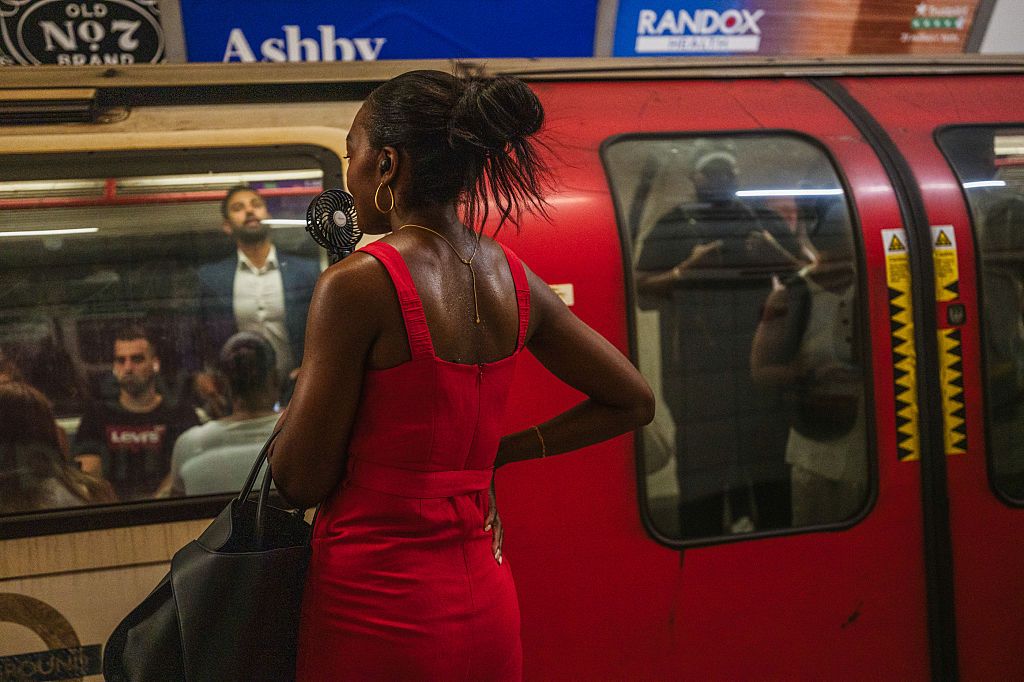The highest temperature that Jonathan Paul has ever recorded in a London Tube station is about 42 Celsius, or 107.6 Fahrenheit. Paul, a researcher at Royal Holloway, University of London, uses his thermometer-equipped smartphone to take such readings. 42C is the kind of heat that would send someone running to the nearest air-conditioned building. Underground, though, they can’t. There’s nothing but stifling tunnels and screeching trains down here.
The Tube network runs through thick clay, and that dense material has been soaking up heat generated by trains since the tunnels were first dug, in some cases more than 100 years ago. Fitting air-conditioning units to trains risks heating up the tunnels even more, as warm air from inside carriages gets dumped into the aging tubes.
But Paul has an idea to cool the tunnels themselves. “Water, as a refrigerant, can hold huge amounts of heat,” he says. “It’s everywhere beneath London.” He’s working on a technology that would use groundwater at roughly 10 Celsius to ferry excessive heat away from underground stations. And he’s testing it deep in a chalk quarry to the west of London, near the town of Reading.
Trains, being metal tubes packed with people, are hard to cool down. But as summers get hotter due to climate change, ensuring public transport remains comfortable and safe is becoming ever more important. It’s a global issue. Train riders in Japan and Morocco have complained about insufficient air-conditioning during heat waves this year, and a 2023 study reported train carriage temperatures as high as 47 degrees Celsius in India.
Paul, for one, has witnessed the effects of overheating on commuters using overground trains. “I’ve seen four people faint this summer,” he says.
The first air-conditioned trains date back roughly a century. One 1933 article put it like this: “Until now, every one has dreaded a railway journey in summer.” If only they could have seen the future. Today, trains and underground transport networks can be so uncomfortable during heat waves that many passengers avoid using them altogether.
Paul and his colleagues believe their solution will work. Climb 20 meters down a ladder into that chalk quarry near Reading and you will find it. There are multiple galleries of varying sizes carved into the chalk, separated by doors. “We’re trying to simulate real-life conditions in the Tube,” says Paul—though things down in the quarry are a little more drab. “It’s very dark, it’s quite dingy.”
In 2022, he and a colleague published a paper that described how water from subterranean rivers or aquifers could be pumped into heat exchangers attached to the ceiling above subway platforms. Hot air sucked into these exchangers would pass some of its warmth to the water, allowing cool air to blow out the other side. The warmed water would flow gently away through the ground—perhaps to be cooled down or otherwise treated elsewhere.
A prototype of this setup is now installed at the chalk quarry. “For nominal pumping rate over the course of about an hour we can shift the temperature of the [bedroom-sized] room down about 10-11 degrees [Celsius],” says Paul. He and his colleagues still need to test how it would perform in large rooms, and, crucially, he’s not sure whether Transport for London (TfL)—the body that operates the Tube—would ever implement it for real.
However, Paul argues the system could be a significant improvement on a similar technology tested by TfL back in 2006. That technology, which is no longer in use, attempted cooling using groundwater that had leaked into‚ and then been pumped out of, Victoria Tube station in central London. Paul suggests that this fluid wouldn’t have been as cool as water directly tapped from nearby aquifers or subterranean rivers. He adds that his system uses special filters to reduce the risk of chalky water causing excessive limescale and blockages.
WIRED asked TfL whether it would consider using the system Paul and his colleagues have come up with. Although TfL declined an interview, Melvin Lim, a spokesman, says the body has had to “carefully prioritize” investments in recent years. He emphasized the introduction of new trains for the Piccadilly Line next year, which will feature air-conditioning: “We stay open to measures that will help manage the impact of increasing temperatures due to climate change.”
TfL, to its credit, has made many efforts over the years to try to deal with the problem of hot tunnels, including attaching cooling panels to tunnel walls. The panels, which circulate water to remove heat from the air, were deployed in a trial in 2022, though they are not currently in use. Paul argues that such a system could be prohibitively expensive.
Hassan Hemida at the University of Birmingham says Paul’s water-cooling technology is a “good idea,” though it remains to be seen how much heat it could really remove from a real-life, busy Tube station full of people.
Certain railways simply push the boundaries of our ability to cool things down, says Hemida. He gives the example of super-high-speed trains traveling at, say, 400 kilometers per hour. They force air out of their way at high velocities, meaning the air pressure surrounding heating, ventilation, and air-conditioning (HVAC) equipment on the roofs of those trains can drop significantly. “Then, you cannot suck air into the HVAC system,” he says. Ultimately, that could cause the air-conditioning unit to fail. “I have been contacted by colleagues from China, and they want to find a solution for this problem,” Hemida adds.
More and more train operators are adopting air-conditioning systems as standard, though. London’s still relatively new Elizabeth Line features air-conditioning, for example. And a spokesman for Škoda Transportation, which recently rolled out air-conditioned metro trains in the capital of Bulgaria, says: “Generally, every vehicle we produce now is equipped with AC.” Sharon Hedges, senior engagement manager at Transport Focus, an industry watchdog, adds: “As people think about procuring new rolling stock, these are the kind of things that need to be uppermost in minds now.”
Heat waves are one thing in Britain. What about the Egyptian desert? German tech company Siemens is supplying Egypt with a new set of high-speed trains that can travel at speeds of up to 230 kilometers per hour. The firm’s Velaro trains are used in many places around Europe, but for Egypt, Siemens has really put them through their paces. Last summer, the company took one of the trains to a test facility in Austria and exposed it to unpleasant conditions, including temperatures as high as 60 degrees Celsius and high winds. “We are achieving 26 degree inside temperature at the hottest outside conditions,” says Björn Buchholz, head of HVAC and door systems.
“We added a special filter system,” he adds, explaining that this will help to remove sand and dust entering from the Egyptian desert, to keep the AC operating as designed.

A Siemens Velaro train in Egypt.
Photograph: Courtesy of Siemens
While air-conditioning is popular with weary summer travelers, passive cooling measures also have a role to play, says John Lawrence, a consultant for the rail industry at JPL Diversified. Many train stations already have awnings, which shade platforms and carriages while passengers board. But this isn’t always the case. “[The train] can be sat there quite merrily baking in the sunshine—take the opportunity to get rid of some of that solar gain,” says Lawrence.
Once a train is out in the open, highly reflective paints or coatings could help, too. In the UK, the Rail Safety and Standards Board (RSSB), an independent standards and research organization, is planning to trial a selection of such technologies on trains next year. “There is a decent chance that some kind of wrap or reflective coating becomes a cost-effective approach for dealing with this,” says Richard Walker, deputy director of research at RSSB.
Different trains might need slightly different solutions depending on whether they take a north-south or east-west route, adds his colleague Scarlett Hayward Mitchell, a research support analyst. That orientation could affect which parts of the vehicle are more frequently exposed to strong sunshine.
Doing anything with railways is expensive these days. So updates to air-conditioning systems, or liveries, are most likely to take place when train operators make scheduled updates to their rolling stock. In the UK, a program to transfer some rail services into public ownership—making them part of a new entity called Great British Railways—could be a good excuse to invest in new paintwork or liveries for trains. This is partly why the RSSB has decided to research reflective materials right now, explains Walker.
Meanwhile, Paul and his colleagues continue to work on their underground cooling technology at their chalk quarry test site. “We’re building slowly in order to present a case that this can be rolled out operationally,” he says. “We’re maybe a year away from it.”
If he, or anyone, can interest TfL—and successfully cool down the Tube—then perhaps anything’s possible.




